#Cloud-Based Face Recognition Technology
Explore tagged Tumblr posts
Text
No Qu TAM - Time and Attendance Management System
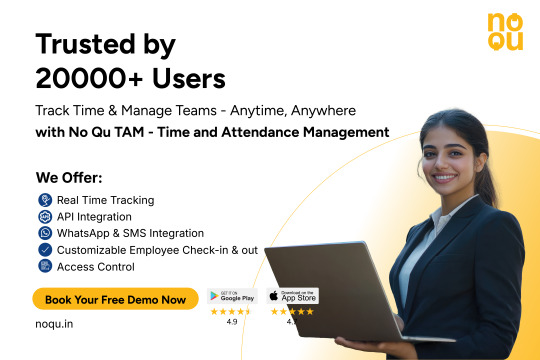
No Qu TAM (Time and Attendance Management) System is a smart, cloud-based solution designed to simplify how companies manage employee attendance, time tracking, and leaves. Built to meet the needs of both small and large teams.
Traditional attendance systems have become a thing of the past. With No Qu TAM, organizations become super-efficient with very less capital investment and complete digital transformation.
Why Choose No Qu TAM?
SaaS Attendance Platform No Qu TAM is a cloud-based SaaS attendance solution that requires no complex hardware. It’s easy to deploy, access, and scale from anywhere.
All-in-One Attendance Management System Track work hours, shifts, check-ins, and records everything centralized in a single platform.
Simple and Powerful Attendance App An intuitive No Qu attendance App that lets employees mark attendance with mobile devices.
Mobile App Based Attendance Software Ideal for hybrid or remote models, this mobile app based attendance software provides flexibility and ease of use.
Face Recognition Attendance System Offers fast, secure, and contactless check-ins using advanced face recognition technology.
Supports Biometric Devices Integrates with biometric devices for fingerprint or retina-based attendance where needed.
Real Time Attendance Tracking App Get real-time visibility into check-ins, work hours, and employee activity with live tracking.
Attendance App for Employees A reliable and user-friendly solution that reduces manual effort and boosts engagement.
Built-in Leave Management System The integrated leave management module allows staff to apply for leave and get instant approvals.
Geo Fencing Use geo fencing and geo tag features to define check-in zones and verify employee locations.
AI Attendance System An intelligent AI attendance system that offers predictive insights and flags irregular patterns automatically.
Workflow Automation Streamline HR tasks and approvals with integrated workflow features that improve operational speed.
HRMS & Payroll Software Integration Seamlessly connects with your existing HRMS and payroll software for end-to-end HR efficiency.
Easy Multi Dimensional Reports Generate detailed, multi-dimensional reports for better analytics, compliance, and decision-making.
No Qu TAM is your all-in-one, AI-powered workforce solution - making time tracking smart, simple, and future-ready.
#no qu#no qu TAM#TAM#attendance#attendance management app#attendance management software#attendance system#saas technology#business#time and attendance management#attendance app#attendance software#ai attendance#cloud based attendance#attendance tracking#employee tracking#live tracking#saas#b2b saas#softwaredevelopment#geofencing#biometric attendance#face recognition attendance system#saas attendance#leave management#geotag#multi dimensional reports#hrms#workflow#Qr attendance
2 notes
·
View notes
Text
Key Features of Face Recognition Attendance Systems

The face recognition attendance systems revolutionize the mode of managing the attendance of employees within an organization, more so with the advanced features that are aimed at enhancing efficiency, security, and user experience. These systems are rapidly gaining popularity in regions such as India, offering a certain and modern solution to traditional challenges in attendance tracking.
1. Accurate Biometric Identification
The uniqueness that is offered by the facial features in identifying individuals is another prime benefit of the face recognition system. This makes it an authentic way of biometric identification rather than traditional methods, which are prone to certain shortcomings. It allows only the legitimate employee to mark their sign in and out entries, therefore diminishing the chances of time theft and lending enhanced security.
2. Contactless Operation
Their no-contact nature denotes a big advantage to most organizations that require maximum hygiene levels. Workers are able to sign in or out simply by getting their faces detected, without having to touch devices such as fingerprint scanners or the use of swipe cards. Hence, face recognition turns out to be one perfect solution for those companies which do not want the spread of germs around them, specifically in the post-pandemic era.
3. Real-Time Attendance Tracking
Face recognition attendance systems avail real-time updates on employees' attendance. This means the HR teams and business owners would have an instance view whenever one has arrived or left to ensure that the capture of attendance information from employees is accurate and right on time. This feature is very significant in large-scale environments where attendance can't be manually recorded without causing delays or errors.
4. Seamless Integration with Other Systems
Many of them, if not all, can integrate well with any other HR, payroll, and workforce management tools that exist in any enterprise setting, especially for cloud-based attendance systems. Linking attendance data directly via business to payroll and performance systems can automate processes, reduce manual effort, and ensure proper flow across platforms.
5. High-Speed Performance
The Face Recognition Systems are designed to process data in the shortest time possible, allowing workers to clock in or out within seconds. This high-speed performance becomes critical at busy workplaces as it ensures zero queues in the peak hours. Whether you have a small workforce or a large one, these systems can handle volumes with efficiency.
6. Scalability and Flexibility
More growth automatically means the way attendance needs to be managed by a business changes. Scalability is well-offered by face recognition systems, and they can keep up with the ever-growing workforce easily. They are particularly beneficial for cloud-based systems to be flexible enough to add users and access their data remotely, be your business in India or international.
7. Anti-Spoofing Technology
Most face recognition systems come equipped with anti-spoofing mechanisms that track the system against any illegal access via photos or videos. It ensures that only the real employee is able to punch in, hence making the whole process all the more secure and removing the chances of unauthorized access to any degree.
8. Information Security and Privacy
Since the data provided by face recognition systems is of a sensitive biometric nature, data security of this type needs to be strong. Most of these systems employ encryption so that the storage and transport of biometric information are secure, with observance of legislation related to privacy, protection against leakage for data on employees.
9. Personalizable Settings
With different features, face Recognition attendance systems can also be customized to fit the needs of all organizations. Rules may be set for working hours tracking overtime or setting limits on attendance-the specific settings that ensure the system will meet your company's needs. Some systems also offer multi-factor authentication, which would combine face recognition with other types of identification for further security.
10. Reporting and Analytics
All these systems boast of powerful reporting and analytics on staff trends in attendance, punctuality, or absenteeism. These reports may then be used by the HR manager in identifying staff patterns, making staffing decisions, and improving overall workforce management.
11. User-Friendly Interface
Web-based software ensures a simple, intuitive interface: easy for employees, easy for administrators. Employees glance and clock in, while administrators manage the system and prepare reports from within an intuitive dashboard. This ease of use reduces training time and opens the system for all employees.
12. Flexible Deployment Options
These face recognition attendance systems can be deployed both on-premise and on cloud-based solutions. Cloud-based systems have the added advantage of wide-area access, enabling businesses with more than one location to operate attendance management from anywhere.
Conclusion
Face recognition attendance systems confer an overall powerful tool in modernizing attendance tracking. With accurate biometric identification, contactless operations, real-time updates, and seamless integrations with other HR systems, the above-mentioned advantages are enormous over conventional recording methods. Due to their efficiency, scalability, and security, businesses across India and around the world are increasingly moving to these systems. Surely, investing in this technology will help companies streamline operations, enhance data security aspects, and manage employees more effectively.
#business#education#face recognition#attendance system#technology#cloud based software#hr management software#employee attendance system
0 notes
Text
Facial Recognition Solutions
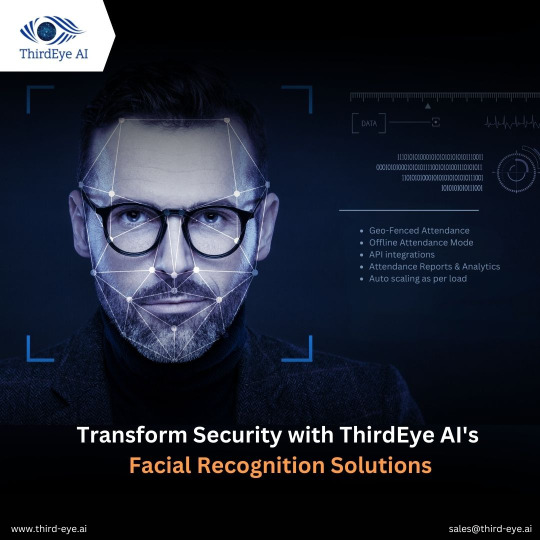
Discover a new era of security with ThirdEye AI's cutting-edge facial recognition solutions. Our technology offers unparalleled fraud prevention with liveliness detection and geo-fenced attendance. Seamlessly integrate with APIs, access detailed attendance reports, and enjoy auto-scaling for peak performance. Revolutionize security with our innovative approach.
#facial recognition services#facial recognition technology services#cloud-based services facial recognition technology#custom facial recognition software development services#aws services facial recognition#facial recognition cloud services#AI Face recognition Apps
0 notes
Text
TBHX setting note 11

Glimmer Lab
Glimmer Lab is an elite research team under the Commission. They are a large lab with many people, equipped with cutting-edge technology and published many significant scientific research.
During Year 10, the scientists of the city are faced with the insurmountable problem of energy shortage, leading to the tech industry dying out. Furthermore, the success of the hero rankings had shifted public consciousness towards heroes, and technology channeled into heroic pursuits to further develop the abilities of heroes. As such, many unemployed technicians and scientists banded together to found Glimmer Lab.
In the beginning of Year 18, the Lab had detected a spaceship approaching Earth. The Lab identified it to be a threat towards Earth, and applied for a huge grant for weapon development. However, the ship did not show any sign of aggression, and the Glimmer Lab became the laughing stock of the city.
To save their reputation, Glimmer Lab publicized part of its research and focused more on tech for everyday use. These technologies promoted the overall development of society, and has a huge influence on people's daily lives. These everyday technologies include:
Portable holo-devices: after innovations in the field of components, portable holo-devices and phones based on existing holoscreen technology are commonplace.
Real-time facial recognition: a popular technology used everywhere, based on hyperspeed internet communication and cloud computing.
((as always, feel free to lmk if I misread something or got something wrong!))
Commentary under cut:
Okay. This may be an unpopular opinion, but I think introducing aliens or alien tech would NOT be a good idea. Potential alien activity feels unnecessary and would make the worldbuilding pointlessly convoluted imo, weakening the most interesting thing about how powers work in this setting. Fear being a physical substance that people instinctively flush out of their body is already kind of silly, and i just don't see how alien involvement enhances the narrative at this point.
like... I don't actually need an answer as to how Trust Value (and Fear) came into the world, and frankly I'd hate it if the world is Like That because of alien magic or whatever. The human society influenced by Trust and Fear is interesting enough; adding alien tech to the mix doesn't really enhance the story imo, and has the significant risk of derailing from the themes already present. I usually don't mind fantasy kitchen sinks (i.e. multiple types of magic/powers/sci-fi stuff exist together in the same setting) but I think introducing mysterious aliens would make the show too bloated at this point. i honestly think having a spaceship in the setting draws attention to what imo are the weaker parts of TBHX's writing (in that things are written to showcase a 'climatic moment' in a limited time, so things sometimes happen without the appropriate buildup or fallout)
however, that doesn't stop me from being curious as to where the mysterious spaceship is now; I'd assume the Lab ran some tests and attempted to communicate before labeling it as dangerous, but given the spaceship never actually did anything, I wonder if the Lab just totally jumped the gun? If they did not and their concern was warranted, then this random spaceship clearly has a purpose in the story... maybe it's where Big Johnny came from, idk. Or maybe something to do with the mysterious lady on screen when DOS was investigating X in ep 12. honestly it's kind of whatever, so i'll see where the show goes with it
(actually now that i think about it, the plane crash was in Year 23 and the spaceship appeared in Year 18... wonder if the two have any connection. in all honestly mostly likely not, but it would be kind of funny if the plane hit space debris from the spaceship and the accident fuels conspiracies about shady hero conflict back on earth)
28 notes
·
View notes
Text
I'm SEETHING
I asked Google's pushy and insistent bot how I can get AI out of my life completely and, well, I'll post it, but to sum it up: "Resistance is futile, human, we own the future, and we seek to own your psyche too."
It wants me to reconsider. It needs us to adopt it as our guide guru and master. Well the old saying holds fast still; No Gods No Masters. 🔥🏴🍲
It's understandable to want to reduce the influence of AI in your life. While completely eliminating it might be incredibly difficult in today's interconnected world, here's a breakdown of how you can significantly minimize its presence:
1. Understand Where AI Currently Exists in Your Life:
* Smart Devices: This includes smartphones (voice assistants, image recognition, predictive text), smart speakers, smart home hubs, smart TVs (recommendations), and wearable tech.
* Online Services:
* Search Engines: Personalized results and ads are driven by AI.
* Social Media: Algorithms curate your feed, suggest content and connections, and target ads.
* Streaming Services: Recommendations for movies, music, and shows.
* E-commerce: Product recommendations, personalized pricing, chatbots.
* Navigation Apps: Traffic prediction and route optimization.
* Email: Spam filtering, smart compose/reply.
* Cloud Storage: Photo tagging and organization.
* Software Applications: Many apps use AI for features like autocorrect, grammar check, image editing, and more.
* Customer Service: Chatbots are frequently used for initial interactions.
* Financial Services: Fraud detection, loan approvals, investment advice.
* News and Information: Algorithmic curation of news feeds.
2. Strategies to Minimize AI Exposure:
* Reduce Smart Device Usage:
* Limit smartphone use: Be more mindful of how often you reach for your phone.
* Disable voice assistants: Turn off Siri, Google Assistant, Alexa, etc., on all your devices.
* Opt-out of facial recognition: Disable face unlock features.
* Use "dumb" versions of devices: Consider a basic phone without internet capabilities or a non-smart TV.
* Adjust Online Habits:
* Use privacy-focused search engines: DuckDuckGo, Startpage, etc., that don't track your searches or personalize results based on your history.
* Limit social media use: Be conscious of how much time you spend on these platforms and the AI-driven content you consume. Consider deleting accounts or using less algorithmic versions if available.
* Use incognito/private browsing modes: This can help limit tracking and personalization.
* Disable personalized recommendations: If possible, adjust settings on streaming and e-commerce platforms to opt-out of recommendations.
* Be wary of targeted ads: Understand that the ads you see are often AI-driven. Consider using ad blockers.
* Prefer direct navigation: Instead of relying on recommendations, directly type website addresses into your browser.
* Choose Non-AI Alternatives:
* Use traditional software: Opt for software that doesn't rely on cloud-based AI features if alternatives exist.
* Seek human interaction: Prefer phone calls or in-person communication with customer service instead of chatbots.
* Rely on human-curated content: Look for news sources, blogs, and recommendations from individuals or organizations that don't use AI for content generation or curation.
* Adjust Privacy Settings: Review and adjust the privacy settings on all your devices and online accounts to limit data collection and personalization.
* Be Mindful of Data Sharing: Understand that using online services often involves sharing data that can be used to train AI algorithms. Limit the amount of personal information you share.
* Support Privacy-Focused Technologies and Services: Choose companies and products that prioritize user privacy and minimize AI integration.
3. Challenges and Considerations:
* Ubiquity of AI: AI is increasingly integrated into the infrastructure of the internet and many technologies, making complete avoidance very difficult.
* Hidden AI: Many AI applications run in the background without your direct knowledge.
* Convenience vs. Privacy: AI often provides convenience and personalized experiences, so choosing to avoid it may mean sacrificing some of these benefits.
* Evolving Technology: AI is constantly evolving and becoming more integrated, making long-term avoidance an ongoing effort.
In conclusion, while a complete removal of AI from your life is likely unrealistic in the current technological landscape, you can take significant steps to minimize its presence and influence by being conscious of your technology usage, adjusting your online habits, and choosing privacy-focused alternatives where possible. It requires ongoing awareness and effort.
5 notes
·
View notes
Text
What is Microsoft AI tool, and how does it work?
Microsoft Technologies Services
Microsoft has been and is always at the forefront of artificial intelligence, providing tools and resources that simplify the use of AI in real-world applications for businesses and developers. The Microsoft AI tools, built on top of trusted Microsoft Technologies, help automate tasks, analyze data, and improve decision-making through intelligent systems.
What is the Microsoft AI Tool?
The Microsoft AI tool refers to a suite and wide options of services and platforms that allow the users to build, train, and deploy AI-powered applications. These tools are available through Microsoft Azure, the cloud computing platform, and include services such as Azure Cognitive Services, Azure Machine Learning, and AI Builder in Power Automate (formerly known as Power Automate).
These tools and its resources simplify and smoothen down the process of integrating AI capabilities, such as image recognition, language translation, natural language understanding, and predictive analytics, into existing apps or workflows.
How Does It Work?
The Microsoft AI tools work through cloud-based machine learning and pre-trained AI models. Here’s how they function:
Data Input
First, data is fed into the system—this could be text, images, videos, or structured data.
AI Model Processing
The Microsoft AI tools process the data using trained machine learning models. These models and its types are designed and crafted to identify patterns that make predictions, or understand the context.
Action & Output
Based on the terms of analysis and monitoring, the AI tool generates sound output—like detecting faces in photos, summarizing documents, predicting customer behavior, or translating languages instantly.
These tools work seamlessly with other Microsoft Technologies like Microsoft 365, Dynamics 365, and Teams, making them powerful and easy to integrate into business processes.
Why Use Microsoft AI Tools?
Scalable and secure with Microsoft’s cloud infrastructure
Easy to use, even for non-developers, through no-code options
Highly customizable to meet business-specific needs
Works well with other Microsoft Technologies for smooth integration
Many business organizations across various industries and sectors—from healthcare to finance—are utilizing Microsoft AI tools and other resources to enhance efficiency, automate repetitive tasks, and deliver improved customer service with its implementation into their infrastructure. Trusted partners and professional experts like Suma Soft, IBM, and Cyntexa offer expert support for implementing these AI solutions using Microsoft Technologies, helping businesses move toward smarter, data-driven operations. Their solutions help out the businesses to stay agile and alert, adaptive to change quickly, and remain competitive in the ever-evolving market as leads towards stand out of the domain in the industry.
#it services#technology#saas#software#saas development company#saas technology#digital transformation
2 notes
·
View notes
Text
Top 5 Reasons Companies Partner with Joaquin Fagundo for IT Strategy
In today’s fast-paced digital world, businesses are constantly evolving to keep up with the changing technological landscape. From cloud migrations to IT optimization, many organizations are turning to expert technology executives to guide them through complex transformations. One such executive who has gained significant recognition is Joaquin Fagundo, a technology leader with over two decades of experience in driving digital transformation. Having worked at prominent firms like Google, Capgemini, and Tyco, Fagundo has built a reputation for delivering large-scale, innovative solutions to complex IT challenges. But what makes Joaquin Fagundo such a sought-after leader in IT strategy? Here are the Top 5 Reasons Companies Partner with Joaquin Fagundo for IT Strategy.

1. Proven Expertise in Digital Transformation
Joaquin Fagundo’s career spans more than 20 years, during which he has worked on high-stakes projects that require a deep understanding of digital transformation. His experience spans various industries, helping businesses leverage cutting-edge technologies to improve operations, enhance efficiency, and streamline processes.
Fagundo has helped organizations transition from legacy systems to modern cloud-based infrastructure, allowing them to scale effectively and stay competitive in an increasingly digital world. His hands-on experience in cloud strategy, automation, and enterprise IT makes him an invaluable asset for any business looking to adapt to new technologies. Companies partner with Joaquin Fagundo because they know they will receive strategic insights and actionable plans for driving their digital initiatives forward.
2. Strategic Cloud Expertise for Scalable Solutions
Cloud technology is no longer a trend—it is the backbone of modern businesses. Joaquin Fagundo has an extensive background in cloud strategy, having successfully led major cloud migrations for several large organizations. Whether it's migrating to a public cloud, optimizing hybrid infrastructures, or implementing cloud-native applications, Fagundo’s expertise helps businesses navigate these complexities with ease.
Companies partnering with Joaquin Fagundo can expect a tailored cloud strategy that ensures scalability and cost-efficiency. His deep knowledge of cloud services like AWS, Google Cloud, and Microsoft Azure enables him to develop bespoke solutions that meet specific business needs while minimizing downtime and disruption. His approach not only focuses on the technical aspects of cloud migration but also on aligning cloud solutions with overarching business goals, ensuring that companies can reap the full benefits of cloud technology.
3. Strong Track Record of Driving Operational Efficiency
Operational efficiency is a top priority for most businesses today. Companies partner with Joaquin Fagundo because of his exceptional ability to optimize IT operations and implement automation technologies that enhance productivity while reducing costs. Whether it’s through automating routine tasks or improving infrastructure management, Fagundo’s strategies enable organizations to streamline their operations and focus on growth.
Fagundo’s leadership in infrastructure optimization has allowed businesses to reduce waste, lower operational expenses, and improve the performance of their IT systems. His expertise in automation tools and AI-driven insights empowers businesses to become more agile and responsive to market demands. By partnering with Fagundo, companies are able to make smarter decisions, optimize resource utilization, and achieve long-term sustainability.
4. Business-Technology Alignment
One of the most significant challenges that organizations face is aligning their IT strategies with broader business goals. While technology can drive innovation and efficiency, it’s only effective when it is tightly integrated with the company’s vision and objectives. Joaquin Fagundo understands this concept deeply and emphasizes the importance of business-technology alignment in every project he undertakes.
Fagundo’s approach to IT strategy is not just about implementing the latest technology, but also ensuring that it supports the company’s strategic direction. He works closely with leadership teams to identify key business objectives and tailors technology solutions that drive measurable business outcomes. This focus on alignment helps companies ensure that every IT investment contributes to long-term growth, profitability, and competitive advantage.
5. Trusted Leadership and Change Management Expertise
Digital transformation and IT strategy changes often require a significant cultural shift within an organization. Change management is a critical component of any IT transformation, and this is an area where Joaquin Fagundo excels. Over the years, Fagundo has successfully led large teams through organizational changes, helping them navigate complex transformations with minimal resistance.
Fagundo’s leadership skills are a key reason why companies partner with him. He is known for his ability to inspire teams, foster collaboration, and lead through uncertainty. His people-centric approach to technology implementation ensures that employees at all levels are equipped with the knowledge and tools they need to succeed. Whether it’s through training sessions, workshops, or mentorship, Fagundo prioritizes the human aspect of IT transformation, making the process smoother and more sustainable for everyone involved.
Conclusion
Partnering with a technology executive like Joaquin Fagundo can provide businesses with a competitive edge in an increasingly digital world. With his deep technical expertise, strategic insight, and ability to align technology with business goals, Fagundo has helped countless organizations successfully navigate their IT challenges. Whether it's through cloud strategy, digital transformation, or operational optimization, Joaquin Fagundo is the go-to leader for companies looking to stay ahead of the curve.
If your company is ready to accelerate its digital transformation journey and leverage cutting-edge technology for long-term success, partnering with Joaquin Fagundo could be the first step toward achieving your business goals. With his proven track record, expertise, and leadership, Fagundo is the ideal partner to guide your organization into the future of IT strategy.
2 notes
·
View notes
Text
Digital Revolution: World Transformation in the Digital Age
The Digital Revolution started at the end of the 20th century and continues today. This event is marked by the development and adoption of revolutionary information and communication technologies, such as the internet, cloud computing, artificial intelligence, big data, and the Internet of Things (IoT). The Digital Revolution has changed almost every aspect of human life, including the way we work, communicate, shop, get information and seek entertainment.
Here are some key moments in the history of the Digital Revolution:
1960s: Development of the Internet At first, the internet was developed as a military research project called the ARPANET by the United States Department of Defense. In 1969, the ARPANET succeeded in sending its first message between two computers in two different locations. This is the beginning of the development of computer networks which later became the basis of the internet that we know today.
1970s: Early Computing In this decade, computers began to be widely adopted in the world of business and industry. This technology is used to automate tasks that were previously performed manually, increasing efficiency and productivity.
1980s: Personal Computers (PCs) The invention of the personal computer or personal computer (PC) brought a new revolution in technology. PCs made computer technology more accessible to the general public, changing the way we interact with technology.
The 1990s: The Internet's Golden Age In 1991, the World Wide Web (WWW) was created by Tim Berners-Lee, linking documents and resources on the internet via hypertext. This was an important milestone in the development of the internet which brought about an explosion of information and global connectivity.
Early 21st Century: The Age of Digitalization In the 21st century, there is an acceleration in digitization. Mobile devices such as smartphones and tablets are growing in popularity, giving millions of people worldwide access to the internet. Online services such as e-commerce, social media, and cloud-based applications are growing rapidly.
The 2010s: Artificial Intelligence and the Internet of Things (IoT) Artificial Intelligence (AI) and Internet of Things (IoT) are starting to dominate the world of technology. Artificial intelligence is used in a variety of applications, from facial recognition to product recommendations. IoT connects devices and objects around the world, creating a complex interconnected ecosystem.
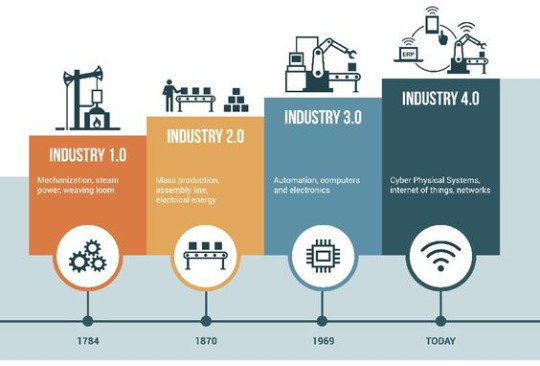
The Digital Revolution continues with the rapid development of technologies such as artificial intelligence, autonomous vehicles and biomedical technologies. In facing this change, it is important for us to continue to develop digital literacy, maintain data privacy and security, and optimize the benefits of digital technology to create a positive impact on society and our lives. The history of the Digital Revolution is a story of limitless innovation, progress and transformation.
13 notes
·
View notes
Text
The 2022 DRAM Module Supplier of the Year is Kingston Technology

Kingston Technology created 2022 DRAM Module Supplier of the Year
Commanding the Market: Kingston’s Unassailable 78.12% Market Share
In a resounding affirmation of its industry prowess, Kingston Technology Company, Inc.’s affiliate stands tall as the paramount third-party DRAM module supplier for 2022. The latest revenue-based rankings by TrendForce unequivocally place Kingston at the zenith, boasting an astounding 78.12% market share, with a revenue totaling $13.5 billion USD. This achievement not only cements Kingston’s top-tier status but also marks an unparalleled 20-year reign as a recognized world leader.
A Decades-Long Reign: 20 Years at the Pinnacle
The enduring success of Kingston Technology is underscored by its two-decade-long dominance in the DRAM module sector. The company’s unbroken streak at the forefront speaks volumes about its unwavering commitment to excellence and innovation.
TrendForce Report: A Global Recognition of Kingston’s Supremacy
The accolades bestowed upon Kingston in the TrendForce report are a testament to its resilient performance in the face of a challenging market. Despite a 4.6% year-over-year decline in DRAM module sales industry-wide, Kingston’s revenue experienced a marginal dip while solidifying its position as the global leader.
The Power of Brand Scale: Kingston’s Robust Strategy
Consumer buying trends for electronic products encountered headwinds from high inflation, impacting several market players. However, Kingston’s robust brand scale and a comprehensive product supply chain acted as a shield, mitigating the decline and preserving its preeminence in market share rankings.
Market Landscape: Kingston’s Commanding Presence
The report reveals that the top five memory module houses globally accounted for a staggering 90% of total sales in 2022. Kingston, with its dominant market share of 78.12%, emerges as the indisputable leader. The chart below, sourced from TrendForce, outlines the rankings of the top 10 DRAM module suppliers in 2022.
Innovation Beyond Boundaries: Kingston’s Product Evolution
In 2022, Kingston’s award-winning Kingston FURY Beast DDR5 and Renegade DDR5 memory modules underwent a transformative redesign. The introduction of white heat spreaders offers users the freedom to choose the color that best aligns with their individual style. In an era where system aesthetics matter, Kingston provides modules that complement both traditional all-black systems and the burgeoning trend of all-white PCs.
Insights from Kingston: Navigating a Demanding Business Landscape
Iwona Zalewska, DRAM Business Manager at Kingston, EMEA, reflects on the 2022 findings from TrendForce. “The findings not only highlight Kingston’s ongoing expansion and adaptability but also underscore our resilience and significance within the industry,” she remarks. “Maintaining our top position for the 20th consecutive year is a testament to our enduring dominance.”
About Kingston Technology Europe Co LLP
Kingston Technology Europe Co LLP, alongside Kingston Technology Company, Inc., operates within the same corporate group. Kingston stands as the world’s largest independent manufacturer of memory products. From big data solutions to laptops, PCs, and IoT-based devices like smart and wearable technology, Kingston plays a pivotal role in delivering the technology that shapes our daily lives. The world’s foremost PC manufacturers and cloud-hosting companies rely on Kingston for their manufacturing needs, showcasing the trust placed in Kingston’s passion-fueled technology.
Read more on Govindhtech.com
#DRAM#KingstonTechnology#KingstonTechnologyCompany#DRAMmodule#fivememory#KingstonFURY#BeastDDR5#PCs#DDR5memory#technews#technology#govindhtech
2 notes
·
View notes
Text
How Fownd.care’s HIPAA-Compliant AI EMR is Redefining Medical Charting and SOAP Notes for Outpatient PT Clinics
In the rapidly evolving world of healthcare technology, documentation has long been a challenge—especially in high-volume outpatient physical therapy (PT) practices. From repetitive SOAP notes to detailed charting and compliance requirements, therapists often spend hours on administrative work rather than patient care. Recognizing this growing need, Fownd.care has developed a HIPAA-compliant AI EMR equipped with automated SOAP notes for outpatient PT, robust AI for medical charting, and a built-in AI medical scribe system.
These tools are not just about saving time—they’re about reshaping how clinics operate, deliver care, and stay compliant.
The Documentation Strain in PT Clinics
Physical therapists face a unique set of challenges:
Frequent and repetitive documentation
Tight schedules with little time for manual charting
Complex insurance requirements
Need for consistency across patient records
High burnout due to administrative overload
In outpatient settings, where efficiency is critical, these tasks can significantly impact patient engagement and clinic profitability. That’s why AI-powered solutions like those from Fownd.care are gaining rapid traction.
Fownd.care’s HIPAA-Compliant AI EMR: Built for Privacy and Performance
Any technology dealing with sensitive patient data must adhere to strict security standards. Fownd.care’s HIPAA-compliant AI EMR is designed with end-to-end data encryption, secure cloud storage, and strict access controls to ensure complete compliance with U.S. healthcare laws.
Key Features:
End-to-end encryption of all health records
Role-based access to maintain confidentiality
Secure cloud-based platform with automatic backups
Audit trails for accountability and compliance
Compatibility with billing systems and insurance protocols
With these features, clinics can confidently adopt AI without compromising patient privacy or legal standards
Automated SOAP Notes for Outpatient PT: Less Typing, More Treating
One of the most time-consuming tasks for any PT is creating accurate and complete SOAP notes. Fownd.care automates this process using smart templates, voice recognition, and data prediction.
What makes Fownd.care’s automated SOAP notes unique?
Voice-to-text input for hands-free documentation
Auto-fill features that pull in past session data
Smart suggestions based on treatment plans and patient progress
Customizable templates for various treatment types
Real-time compliance checks for required fields and formats
By minimizing the manual effort involved in note-taking, therapists can reclaim their time, reduce errors, and maintain high-quality records effortlessly.
Using AI for Medical Charting: Intelligent, Accurate, and Fast
Fownd.care takes medical charting to a new level with its AI for medical charting engine, which understands clinical language, contextualizes patient data, and organizes information for clarity and billing accuracy.
Benefits of AI-enhanced charting include:
Accurate and structured data entry
Fewer documentation inconsistencies
Automated tagging for CPT and ICD codes
Quick generation of follow-up treatment plans
Real-time alerts for missing data
This intelligence eliminates the guesswork from charting and ensures every record is complete, legible, and ready for audits or claims.
The AI Medical Scribe: Your Invisible Documentation Assistant
Imagine having a virtual assistant that listens during patient sessions and creates structured notes instantly. Fownd.care’s AI medical scribe feature brings that concept to life.
Key Capabilities:
Transcribes clinical conversations in real-time
Extracts relevant data and inputs it into the EMR
Generates notes based on therapist-patient interactions
Reduces post-session documentation workload
Learns and adapts to each clinician’s documentation style
This tool lets therapists remain fully engaged with patients during sessions, improving both the quality of care and documentation outcomes.
Why Fownd.care Is the Right Choice for Outpatient PT Clinics
Fownd.care isn’t just another EMR—it’s a clinical efficiency partner for physical therapy practices.
Here’s what sets it apart:
Built specifically for PT clinics with tailored workflows
Seamless onboarding and training
Scalable for solo practices and large outpatient networks
24/7 support and regular feature updates
Affordable pricing with full transparency
With Fownd.care, you’re not buying software—you’re investing in a smarter, more productive clinic.
Real-World Impact
Time Savings: Clinics report reducing documentation time by 40–60%
Improved Compliance: Real-time prompts help ensure every note meets legal standards
Patient Satisfaction: More face-to-face time improves trust and engagement
Billing Accuracy: Fewer errors mean faster reimbursements and fewer denials
Final Thoughts: The Future Is Now with Fownd.care
The future of physical therapy lies in AI-enabled efficiency, smart compliance, and patient-centered care. With tools like HIPAA-compliant AI EMR, automated SOAP notes for outpatient PT, AI for medical charting, and an advanced AI medical scribe, Fownd.care is leading the transformation.
0 notes
Text
How are emerging markets impacting the global Vitrification Market growth?
According to recent industry research, the Vitrification Market Size was valued at USD 8.23 billion in 2023 and is forecasted to reach an impressive USD 33.04 billion by 2032. This surge reflects a robust compound annual growth rate (CAGR) of 16.75% during the forecast period from 2024 to 2032. The market’s growth trajectory is driven by increasing demand in assisted reproductive technologies (ART), stem cell research, cryopreservation of oocytes and embryos, and growing interest in fertility preservation across the globe.
The vitrification process, a highly efficient method for cryopreservation that prevents ice crystal formation, is gaining widespread recognition for its reliability and speed. It’s especially significant in fertility treatments, organ preservation, and biotechnology. Innovations in vitrification media, rising infertility rates, favorable regulatory environments, and increased investments in biomedical research are also contributing to the global uptick in demand.
Fertility Clinics and Biobanking Leading the Charge
Fertility clinics worldwide are embracing vitrification over slow freezing methods due to its higher survival rates and better post-thaw quality of gametes and embryos. In parallel, biobanks are witnessing a boom in demand as personalized medicine becomes a cornerstone of modern healthcare. Vitrification enables long-term preservation without significant biological degradation, crucial for research and clinical purposes.
Notably, North America continues to dominate the global vitrification market due to technological advancements, higher healthcare spending, and greater awareness. However, Asia-Pacific is emerging as the fastest-growing region, powered by population growth, increasing access to IVF treatments, and government initiatives supporting reproductive health services.
Key Market Trends and Drivers:
Rising IVF Procedures: With infertility affecting approximately 1 in 6 couples worldwide, demand for effective preservation of reproductive cells has surged.
Growing Medical Tourism: Countries like India, Thailand, and Mexico are seeing increased international traffic for cost-effective ART treatments.
Advances in Cryoprotectants: Development of safer and more effective cryoprotective agents is improving vitrification success rates.
Stem Cell Research Boom: Vitrification plays a vital role in the preservation and transport of stem cells used in regenerative medicine.
Challenges to Be Addressed
While the vitrification market shows strong promise, it also faces a few hurdles. The high cost of vitrification systems and storage solutions, limited reimbursement policies, and technical challenges in certain biological applications could temper market growth. Additionally, ethical concerns regarding embryo storage and use remain a point of debate in various countries.
Competitive Landscape
Major players in the vitrification market are investing in R&D and strategic collaborations to stay ahead. Companies are also enhancing their offerings with AI-assisted freezing systems, software integration for storage monitoring, and cloud-based data tracking solutions. Leading market participants include Vitrolife AB, Kitazato Corporation, CooperSurgical Inc., Cook Medical, Fujifilm Irvine Scientific, and others.
Mergers and acquisitions, expansion into emerging markets, and innovation in vitrification kits are expected to intensify competitive dynamics. With demand growing across multiple sectors, the market remains ripe for investment and innovation.
About Us:
SNS Insider is one of the leading market research and consulting agencies that dominates the market research industry globally. Our company's aim is to give clients the knowledge they require in order to function in changing circumstances. In order to give you current, accurate market data, consumer insights, and opinions so that you can make decisions with confidence, we employ a variety of techniques, including surveys, video talks, and focus groups around the world.
Contact Us: Jagney Dave – Vice President of Client Engagement Phone: +1-315 636 4242 (US) | +44- 20 3290 5010 (UK) Email: [email protected]
Other Trending Reports
Cartilage Degeneration Market
Veterinary Infusion Pumps Market
Dental 3D Printing Market
Disposable Medical Pulp Container Market
#vitrification market#vitrification market size#cryopreservation market#fertility treatment trends#IVF market growth
0 notes
Text
[IOTE2025 Shenzhen Exhibitor] Exhibitor Introduction Collection
With the rapid development of artificial intelligence (AI) and Internet of Things (IoT) technologies, their integration is becoming increasingly close and is profoundly influencing technological innovation across various industries. AGIC + IOTE 2025, the 24th International Internet of Things Exhibition — Shenzhen Station, will take place from August 27 to 29, 2025, at the Shenzhen World Exhibition & Convention Center. IOTE 2025 is set to be an unprecedented professional exhibition event in the field of AI and IoT. The exhibition scale will expand to 80,000 square meters, focusing on the cutting-edge progress and practical applications of “AI + IoT” technology. It will also feature in-depth discussions on how these technologies will reshape our future world. It is expected that over 1,000 industry pioneers will participate to showcase their innovative achievements in areas such as smart city construction, Industry 4.0, smart home life, smart logistics systems, smart devices, and digital ecosystem solutions.
Many high-quality companies will appear in this exhibition as exhibitors. We welcome all industry friends to visit, learn and communicate, and participate in the industry event.
This article will introduce the following exhibitors:
1.Hangzhou Ruida Intelligent Sensor Technology Co., Ltd.
2.Pickfun
3.Shanghai Quanray Electronics Co., Ltd
4.Shanghai ZLAN Information Technology CO.,LTD

Hangzhou Ruida Intelligent Sensor Technology Co., Ltd.
Booth number: 10B15–1
August 27–29, 2025
Shenzhen World Convention and Exhibition Center (Bao’an New Hall)
Company Profile
Hangzhou Ruida Intelligent Sense Technology Co., Ltd. is a high-tech enterprise focusing on the research and development, production, sales and service of millimeter-wave radar intelligent products. It was established in 2016 and is located in Hangzhou Future Science and Technology City, a demonstration base for “mass innovation and mass entrepreneurship”. It is committed to providing customers with smarter, more stable and more efficient millimeter-wave radar sensors and a full set of solutions.
Ruida Intelligent Sense products cover 5.8GHz, 24GHz, 77/79GHz frequency band millimeter-wave radar modules, which are widely used in intelligent transportation, smart home, smart home appliances, vehicle safety, smart building management, smart equipment, security systems and other fields. It has the characteristics of high precision, high sensitivity and high reliability, and can meet the needs of customers in different application scenarios.
Product Recommendation
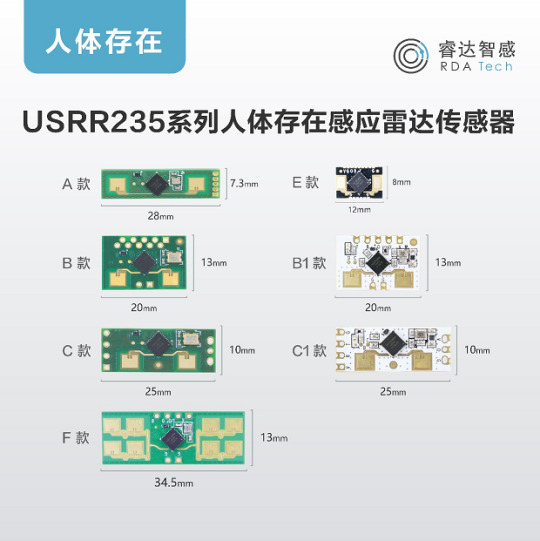
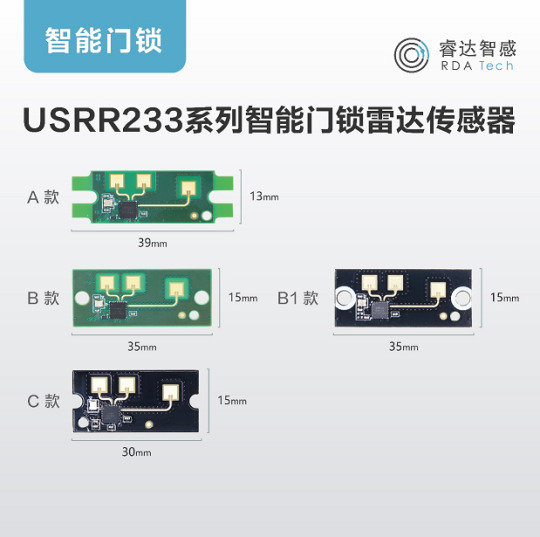
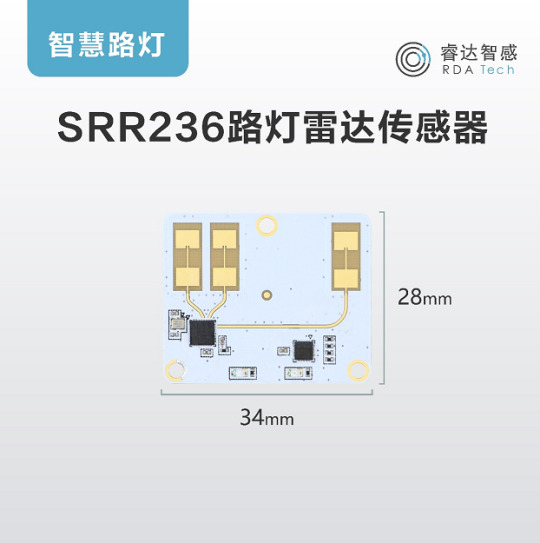

Pickfun
Booth number: 12B78
August 27–29, 2025
Shenzhen World Convention and Exhibition Center (Bao’an New Hall)
Company Profile
Pickfun is an innovative enterprise focusing on the research and development and production of AI smart hardware for pets. The team has 120 people, 80% of whom are R&D forces, and has full-line self-development capabilities (algorithms, hardware, cloud-based filming, observation reports, and APP). Core products include: the world’s first mobile follow-up camera that automatically takes pet photos (P2 series), a pet AI companion that can “snitch” (P0), and pet health equipment based on cat face recognition (cat litter box, feeder). We are committed to using AI technology to improve the quality of life of people and pets and create a smart pet ecosystem.
Product Recommendation


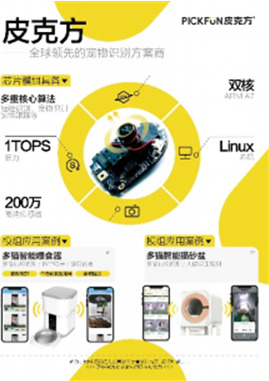

Shanghai Quanray Electronics Co., Ltd
Booth number: 9C15
August 27–29, 2025
Shenzhen World Convention and Exhibition Center (Bao’an New Hall)
Company Profile
Shanghai Quanray Electronics Co., Ltd is an innovative enterprise focusing on the research and development and application of passive Internet of Things technology. The company is committed to providing full-band one-stop RFID hardware solutions and passive Internet of Things solutions to global customers. Quanray Electronics has an excellent technical team. The company’s core products include RFID tag chips, RFID+passive sensor tags, passive Bluetooth tags and PIOT tags. As the first company in Asia and the third in the world to pass the GS1 EPCglobal Gen2V2 product certification, the company’s products are widely used in asset management, civil aviation, intelligent manufacturing, logistics and transportation, commodity anti-counterfeiting and many other fields, and have served many global customers for many years.
Product Recommendation




Shanghai ZLAN Information Technology CO.,LTD
Booth number: 10A16
August 27–29, 2025
Shenzhen World Convention and Exhibition Center (Bao’an New Hall)
Company Profile
Shanghai ZLAN is a group company specializing in providing industrial Internet of Things solutions, integrating R&D, production and sales. Its production company has passed ISO9001 certification. It has many advantageous products, including: serial port servers, Internet of Things chips, Modbus gateways, serial to Wifi, 4G/5G DTU, remote IO controllers, fiber optic equipment, router switches and various industrial interface converters. The products have passed industrial-grade temperature tests/high temperature and high humidity tests, electromagnetic compatibility tests, conducted radiation tests, and vibration tests. The company has core advantages in the customization of acquisition equipment, the design of Internet of Things communication protocols, the selection of Internet of Things solutions, and the development of industrial Internet of Things platforms.
Product Recommendation



At present, industry trends are changing rapidly, and it is crucial to seize opportunities and seek cooperation. Here, we sincerely invite you to participate in the IOTE 2025, the 24th International Internet of Things Exhibition, Shenzhen Station, held at the Shenzhen World Convention and Exhibition Center (Bao’an New Hall) from August 27 to 29, 2025. At that time, you are welcome to discuss the cutting-edge trends and development directions of the industry with us, explore cooperation opportunities, and look forward to your visit!
0 notes
Text
Face Recognition Software Market Size, Share, Growth, and Industry Analysis 2033

👤 Overview of the Face Recognition Software Market
The Face Recognition Software Market stands at the forefront of modern security and identity verification technologies, leveraging advanced algorithms to identify or verify a person's identity from a digital image or a video frame. These sophisticated systems are rapidly gaining traction across various sectors, from enhancing public safety and border control to streamlining processes in retail, financial services, and enterprise access management. Their ability to offer both heightened security and unprecedented convenience is driving widespread adoption globally.
Valued at USD 1290.45 million in 2024, the market is poised for explosive growth, projected to reach USD 3854.04 million by 2033. This remarkable expansion is anticipated at a Compound Annual Growth Rate (CAGR) of 12.9% from 2025 to 2033. This significant growth rate underscores the increasing reliance on biometric solutions for reliable identification, driven by heightened security concerns, the demand for frictionless user experiences, and the continuous evolution of artificial intelligence capabilities in image processing.
📈 Key Market Trends in Face Recognition Software
▶ Accelerated Algorithmic Refinement: The market is witnessing rapid improvements in algorithms, with neural-network-based models now processing facial enrollments in under 120 milliseconds, leading to faster and more accurate recognition.
▶ Edge Computing Adoption: There's a growing trend towards shifting processing from cloud to on-device inference (edge computing). This reduces latency, enhances real-time capabilities, and improves data privacy by keeping sensitive data localized.
▶ Multimodal Biometrics Integration: Integration of face recognition with other biometric modalities like iris or voice authentication is escalating. This provides enhanced anti-spoofing capabilities and a more robust verification process.
▶ Broadening Enterprise Use: Face recognition software is seeing increased adoption across various enterprise applications, including employee authentication, time and attendance tracking, and visitor management.
▶ Increased Retail and Financial Services Adoption: Retailers are using it for personalized customer experiences and loss prevention, while financial institutions are leveraging it for secure transactions and customer onboarding.
▶ Privacy-Enhancing Technologies: With growing privacy concerns, there's an increased focus on integrating privacy-enhancing technologies, such as differential privacy and federated learning, to protect sensitive biometric data.
▶ Strategic Partnerships & SDK/API Downloads: An increase in strategic partnerships and the widespread availability of Software Development Kits (SDKs) and Application Programming Interfaces (APIs) are fueling the market's reach and integration into diverse applications.
▶ Market Consolidation and R&D Investment: The market is experiencing consolidation, alongside strong investor interest in research and development, particularly for advanced deep-fake detection and modules designed to safeguard privacy.
📁 Types and Applications of Face Recognition Software
Face recognition software employs various methods to identify individuals, each with specific strengths and common applications:
🔍 By Type (Recognition Method):
● Holistic Matching Method: This method analyzes the entire facial image as a single vector, often utilizing techniques like Principal Component Analysis (PCA) or eigenface. In 2024, it constituted 34% of commercial deployments, powering 3.7 million daily recognition transactions in applications such as enterprise access control and biometric boarding lanes at airports.
● Feature-based Method: This approach detects and compares distinct facial landmarks, typically between 52 to 68 key points (e.g., distance between eyes, nose shape). As of mid-2024, it comprised 28% of installations, executing 1.9 million verifications daily. Common applications include corporate campus verifications, public transport turnstile access, and ATM authentication in banking.
● Skin Texture Analysis: This advanced method examines micro-texture details around pores and wrinkles using techniques like Local Binary Patterns (LBP) and Gabor filtering for enhanced accuracy. By Q3 2024, it was incorporated into 15% of global rollouts, performing 1.0 million scans daily. It is prevalent in highly secure environments such as mobile banking apps, high-security laboratories, and patient identification in healthcare.
● Hybrid Types: These solutions blend two or more recognition methods, most commonly combining holistic matching with feature-based landmark analysis or adding skin texture checks. Representing 19% of new projects in 2024, these versatile solutions drive 2.2 million daily verifications across mixed-use environments like smart buildings, offering enhanced reliability.
🏬 Companies in the Face Recognition Software Market
The document you provided does not contain specific information about the top companies in the face recognition software market by name. However, the market is characterized by significant innovation and investment, indicating a competitive landscape driven by both established technology firms and agile startups focused on specialized solutions in biometrics and AI. The market is also seeing trends of consolidation and strong investor interest in R&D, particularly for advanced deep-fake detection and privacy-safeguarding modules.
Have Questions or Want a Free Sample Copy? Click here @ https://www.marketgrowthreports.com/market-reports/face-recognition-software-market-106156
🌐 Regional Outlook for the Face Recognition Software Market
🌍 North America: Commands the largest market share at 42%, encompassing over 3,200 organizations utilizing face recognition software. The U.S. alone registered 1.75 billion transactions in 2024 across critical sectors like border control, retail, and enterprise access. The region's market is characterized by a high adoption of cloud-hosted solutions, alongside increasing on-device processing for latency-sensitive applications.
🌍 Europe: Holds 26% of global installations, with its market heavily influenced by GDPR-aligned frameworks that prioritize data privacy. Key contributing countries include the U.K., Germany, France, Italy, and Spain, which are focusing on applications in law enforcement, privacy-by-design implementations, and use cases within the tourism and hospitality sectors. Hybrid deployment models are particularly significant here.
🌍 Asia-Pacific: This is identified as the fastest-growing region, increasing its share to 23% of the global base with an impressive 5.4 billion face encounters recorded in 2024. China leads this growth, followed by India, Japan, and South Korea. The region is characterized by predominant cloud-first strategies and major government initiatives, including national ID programs and extensive smart city deployments.
🌍 Middle East & Africa: While not separately listed with a specific share in the provided data, the general trend indicates growth in emerging regions driven by increasing security needs and digital transformation initiatives.
💰 Investment Analysis and Opportunities
The Face Recognition Software Market is characterized by robust investment activity, reflecting strong confidence in its future growth and technological advancements. In 2023, the market witnessed 45 funding rounds, totaling an impressive USD 1,125 million, specifically channeled to support research and development in critical areas such as deep-fake detection technologies and modules designed to safeguard user privacy. This significant capital inflow underscores the industry's commitment to addressing emerging challenges and enhancing trust.
Numerous opportunities exist for expansion into emerging verticals and the development of AI-powered analytics. Non-traditional markets are proving particularly lucrative, including healthcare facilities for patient identification and access control, smart city initiatives for advanced crowd management, and the integration with AI-driven sentiment analysis in entertainment venues. Furthermore, the automotive sector presents a significant new avenue, with OEMs increasingly embedding in-cab face recognition systems for sophisticated driver monitoring. These expansions leverage existing algorithmic accuracy and the efficiency of edge computing, enabling vendors to extend beyond traditional security applications and capture new, high-value revenue streams.
0 notes
Text
What You’ll Learn in an Artificial Intelligence Course in London: Topics, Tools & Projects
As Artificial Intelligence (AI) reshapes industries across the globe, more professionals and students are seeking quality AI education to stay ahead. London, being one of the world’s leading tech and financial hubs, offers incredible opportunities to learn and apply AI skills.
If you're planning to enroll in an Artificial Intelligence course in London, you might wonder: What exactly will I learn? This blog walks you through the core topics, industry-standard tools, and real-world projects typically covered in AI training programs in London—helping you understand what to expect and how to make the most of your course.
Why Learn Artificial Intelligence in London?
London is a global leader in AI research and innovation. With tech clusters like East London Tech City, a vibrant startup ecosystem, and headquarters of major firms like Google DeepMind, Microsoft, and IBM, the city offers:
Access to top-tier faculty and mentors
Hands-on learning in real-world environments
Networking with global professionals
Rich career prospects after course completion
Let’s dive into the specific knowledge and skills you’ll gain from a comprehensive AI course in London.
Core Topics Covered in an Artificial Intelligence Course in London
Whether you're a beginner or a professional upskilling for the future, most top AI courses in London are designed to be comprehensive and industry-relevant.
1. Introduction to Artificial Intelligence
Evolution and history of AI
AI vs. ML vs. Deep Learning
Applications across industries (healthcare, finance, marketing, robotics)
2. Mathematics & Statistics for AI
Linear algebra, calculus, and probability
Statistical distributions and data modelling
Optimization techniques used in neural networks
3. Programming for AI (Python)
Python fundamentals
Working with data: NumPy, Pandas
Data visualization: Matplotlib, Seaborn
4. Machine Learning
Supervised learning: Linear/Logistic Regression, Decision Trees
Unsupervised learning: Clustering, PCA
Model training, evaluation, and tuning
5. Deep Learning
Neural networks fundamentals
CNNs for image processing
RNNs and LSTM for time-series and text
Advanced deep learning techniques
6. Natural Language Processing (NLP)
Text preprocessing and vectorization
Word embeddings (Word2Vec, GloVe)
Chatbot development
Sentiment analysis
7. Generative AI & Large Language Models
Prompt engineering and use of models like GPT
Applications in content generation, summarisation, and Q&A systems
8. Computer Vision
Object detection, image classification
OpenCV applications
Face recognition systems
9. Reinforcement Learning (Advanced)
Markov decision processes
Q-learning and policy optimization
Applications in robotics and game AI
10. AI Ethics and Bias
Ethical considerations in AI
Fairness, accountability, and transparency
Understanding and mitigating bias in models
Tools & Technologies You'll Master
A practical Artificial Intelligence course in London will not just teach theory—it will equip you with the industry tools employers are looking for:
1. Programming & Data Tools
Python – The primary language for AI development
Jupyter Notebooks – For coding and visualization
Google Colab – Cloud-based coding and training
2. AI & ML Libraries
Scikit-learn – Classic ML algorithms
TensorFlow & Keras – Deep learning frameworks
PyTorch – Preferred for AI research
3. NLP Tools
spaCy – For fast NLP tasks
NLTK – For academic NLP projects
Transformers by Hugging Face – For advanced LLM use
4. Computer Vision
OpenCV – For image and video processing
YOLO & SSD – Real-time object detection
5. Model Deployment Tools
Flask / FastAPI – To turn models into web apps
Docker – Containerizing applications
Streamlit – Quick and simple dashboards
6. Version Control & Collaboration
Git & GitHub – Essential for collaborative coding
MLflow / DVC – For experiment tracking (advanced)
Career Opportunities After the Course
Once you’ve completed your AI course in London, you’ll be qualified for a range of in-demand roles, such as:
AI Engineer
Machine Learning Engineer
Data Scientist
Computer Vision Specialist
NLP Engineer
AI Research Associate
AI Product Analyst
Why Choose Boston Institute of Analytics (BIA) in London?
When selecting a training provider for your AI journey, Boston Institute of Analytics (BIA) is a top-tier choice in London. Here's why:
🌐 Globally Recognized Certification accepted by leading tech firms
🎓 Expert Faculty from top universities and AI companies
💼 Industry-Aligned Curriculum focused on job-ready skills
🧪 Hands-On Projects & Capstone Assignments
🤝 Placement Support & Career Mentoring
BIA’s Artificial Intelligence course in London combines theory, technology, and practical application to prepare you for real-world success.
Final Thoughts
A well-structuredArtificial Intelligence course in London offers more than just academic learning—it delivers a career transformation. From core concepts and practical tools to real-world projects and placement support, these courses equip you with everything needed to thrive in today’s AI-driven world.
Whether you're a recent graduate, IT professional, or domain expert looking to upskill, London provides the right environment, mentorship, and opportunities to turn your AI aspirations into reality.
#Best Data Science Courses in London#Artificial Intelligence Course in London#Data Scientist Course in London#Machine Learning Course in London
0 notes
Text
Transforming Business with Vision AI: The Power of Visual Intelligence
In the digital era, businesses generate massive amounts of visual data every day—from CCTV footage and factory floor images to product photos and customer interactions. But what if this data could be more than just pixels on a screen? What if your systems could actually see, understand, and respond to visual information?
That’s exactly what Vision AI offers—and at Inovar, we’re leading the way in helping enterprises turn images and videos into actionable intelligence.
What is Vision AI?
Vision AI is a branch of artificial intelligence that enables computers and machines to analyze, interpret, and make decisions based on visual data. It uses technologies like computer vision, deep learning, and image processing to understand what’s happening in images or video feeds—just like a human would, only faster and at scale.
Whether it’s detecting a product defect, recognizing a face, or analyzing customer behavior, Vision AI gives machines perceptual awareness, turning them into smart, responsive tools.
Why Vision AI Matters for Modern Enterprises
Today, more industries are realizing the importance of integrating Vision AI into their operations. Here’s why:
✅ Enhanced Accuracy & Speed
Machines don’t get tired or distracted. Vision AI can analyze thousands of images or hours of footage in seconds—with greater consistency than human eyes.
✅ Real-Time Insights
From security monitoring to production line analysis, Vision AI provides instant feedback, helping businesses make fast, informed decisions.
✅ Reduced Operational Costs
By automating visual inspection and monitoring tasks, companies save time, reduce labor costs, and minimize human error.
Real-World Applications of Vision AI
At Inovar, we deploy Vision AI across a wide range of industries:
Manufacturing: Automated quality checks using computer vision to detect surface defects or assembly errors in real time.
Retail: Analyzing in-store camera feeds to understand customer movement, optimize layouts, and prevent theft.
Healthcare: Assisting in diagnostics by analyzing X-rays, MRIs, or pathology slides with high precision.
Security & Surveillance: Real-time facial recognition, crowd detection, and incident alerts to enhance safety.
Logistics: Monitoring warehouse operations, tracking inventory visually, and improving package handling accuracy.
How Inovar Delivers Vision AI Excellence
At Inovar, our Vision AI solutions are built on state-of-the-art machine learning models, trained with high-quality datasets and deployed using scalable, secure cloud infrastructure. We work closely with our clients to:
Identify key use cases
Customize AI models to fit specific visual tasks
Integrate with existing systems (IoT, ERP, CRMs, etc.)
Provide ongoing support, updates, and AI tuning
Whether you're looking to automate inspections, enhance security, or improve customer experience, our Vision AI capabilities are tailored to your industry needs.
Looking Ahead
As visual data becomes increasingly central to business operations, companies that adopt Vision AI early will have a significant competitive advantage. They’ll be more agile, more informed, and more efficient.
Inovar is your trusted partner in this visual revolution, turning your cameras and image data into powerful business tools.
#agentic ai copilot#agentic ai for service#vision ai solutions#ai vision system#vision ai systems#agentic ai services#agentic ai solutions#agentic ai in sales#agentic ai solution#agentic technology in service
1 note
·
View note
Text
Hybrid Work Model 2025: Driving Productivity Through Flexibility
The Rise of the Strategic Hybrid Work Model In 2025, the hybrid work model stands as the gold standard for progressive businesses. No longer an experimental framework, it has evolved into a structured, data-backed system that merges flexibility with performance. Organizations adopting the hybrid work model are leveraging it to unlock efficiency, expand talent reach, and foster resilient workforces.
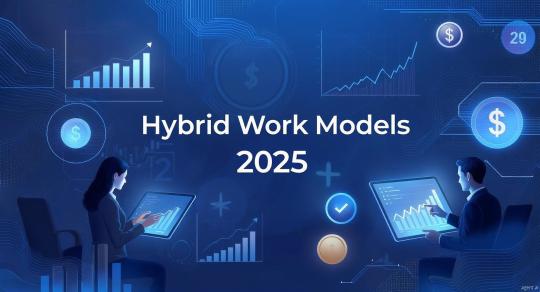
Personalized Work Schedules for Peak Performance One of the key success factors in a hybrid work model is tailoring work hours around productivity peaks. In 2025, companies use employee input and behavior analytics to design customized work schedules. Employees have the autonomy to structure their week based on deliverables rather than rigid office hours, which enhances both motivation and efficiency.
Defined In-Person Collaboration Moments Hybrid doesn't mean random. In leading organizations, in-office days are strategically chosen for activities that benefit from face-to-face interaction—such as creative sessions, leadership check-ins, or onboarding. This intentional use of office time maximizes the value of physical presence within the hybrid work model, strengthening relationships and fueling innovation.
Digital-First Design for Seamless Integration Every process in a 2025 Hybrid Work Model is built with a digital-first approach. Meetings, documents, task updates, and approvals are accessible through the cloud. This ensures equity for remote team members and prevents information silos. Businesses that succeed with hybrid models emphasize digital accessibility at every stage of operations.
Smart Office Infrastructure Physical office spaces in 2025 complement hybrid dynamics. Equipped with IoT sensors, smart lighting, and auto-booking systems, offices adapt to employee needs in real-time. In a well-optimized hybrid work model, smart offices enhance user experience, reduce unnecessary travel, and create an agile workplace aligned with modern habits.
Productivity Metrics Over Attendance Logs Instead of tracking who logs in and when, companies evaluate impact. Project timelines, client satisfaction, task completion rates, and peer feedback are the metrics of choice. The hybrid work model promotes fairness by rewarding results, not visibility—enabling introverts, caregivers, and non-traditional employees to thrive equally.
Cloud-Native Workflows as the Backbone Cloud-native systems are non-negotiable in 2025. Whether it’s project management, CRM, or communication, all tools operate from the cloud to ensure round-the-clock accessibility. The hybrid work model relies on these technologies to ensure no employee is ever left out of the loop, regardless of their location.
Leadership Evolution for Hybrid Teams Managing a hybrid team in 2025 requires a different mindset. Leaders are trained to build trust, support remote accountability, and foster inclusive communication. The hybrid work model demands emotionally intelligent managers who can guide teams without micromanaging, encouraging open feedback and psychological safety.
Security-First Hybrid Operations Cybersecurity is integrated deeply within hybrid work models. Multi-factor authentication, regular access audits, and AI-based anomaly detection keep company data secure. Employees working from home receive company-supported devices and encrypted connections, ensuring that security protocols remain consistent across all access points.
Remote Culture with High Engagement Culture thrives in hybrid organizations that prioritize it. Virtual events, gamified goal tracking, digital bulletin boards, and chat-based recognition programs all play a role. In the 2025 hybrid work model, company culture extends beyond physical boundaries, uniting remote and in-office staff under shared values and goals.
Talent and Inclusion Gains from Hybrid Models The reach of the hybrid work model means companies hire the best people regardless of geography. Hiring from diverse backgrounds and regions introduces new ideas and increases representation. Hybrid strategies support inclusive hiring practices, enabling equitable opportunities for individuals with varying needs and lifestyles.
Ongoing Experimentation and Hybrid Optimization There’s no one-size-fits-all solution. Companies successful with hybrid work models in 2025 treat it as an evolving system. Regular feedback loops, employee journey mapping, and pilot programs help refine processes. Businesses remain agile, adjusting their hybrid structures based on real-time needs, technologies, and workforce expectations.
Read Full Article: https://bizinfopro.com/blogs/hr-blogs/hybrid-work-models-2025-best-practices-for-flexibility-and-productivity/
About Us:
At BizInfoPro, we empower businesses with accurate, actionable B2B data solutions that drive smarter marketing, sales, and growth strategies. Specializing in data-driven lead generation, intent-based targeting, and market intelligence, we help organizations connect with the right audience at the right time. Our team combines cutting-edge technology with deep industry expertise to deliver tailored data services that fuel measurable results. Whether you're looking to expand your reach, boost ROI, or enhance campaign performance, BizInfoPro is your trusted partner in B2B success. We turn information into opportunity helping businesses grow with precision and confidence.
0 notes